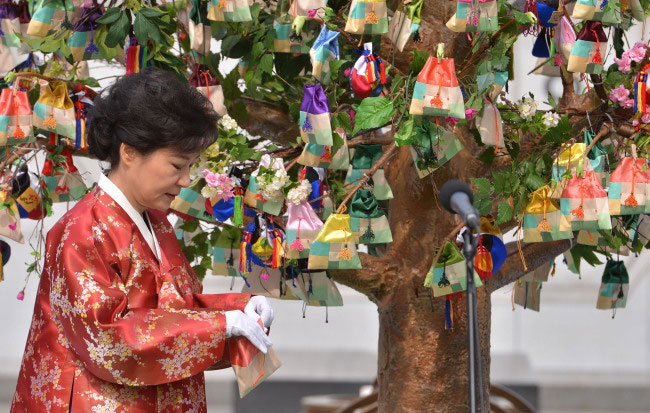An apparently innocent traditional item has found its way to the centre of the influence-peddling scandal surrounding President Park Geun-hye and her longtime confidante Choi Soon-sil.
Obangnang, a multicolored pouch that is a traditional symbol of good fortune, featured in Park’s inauguration ceremony in February 2013 — a giant obangnang setup at Gwanghwanun Plaza opened up to reveal a tree with dozens of mini obangnang hanging from its branches.
Almost four years later and the pouch has come into the spotlight after a file titled “obangnang” was reportedly discovered on Choi’s discarded PC tablet that was uncovered by local media outlet JTBC.
It was later reported that hanbok designer Kim Young-seok, suspected of being a close acquaintance of Choi, was in charge of planning the ceremony and the obangnang installation.
Yet many suspect it was Choi who masterminded the event.
And as she is the daughter of Choi Tae-min, a self-proclaimed pastor and a founder of an obscure religious group called the Church of Eternal Life, the obangnang has come under scrutiny for possibly being associated with the group.
Traditional craftsman are heatedly refuting such allegations against the traditional pouch, which for thousands of years was beloved as a talisman that was thought to ward off evil and bring peace.
“The obangnang dates as far back as the Three Kingdoms Period (57 BC-668 AD),” said Ha Jae-goo, director of the Ssamzisarang Boudoir Craft Academy.
The pouch’s five colors — blue, white, red, black and yellow — are meant to represent the harmony of yin and yang and the planets, he added. These are colors that frequently appear on Korean traditional costumes and decorations.
Such pouches were put to everyday use as Korean traditional attire did not come with sewn-in pockets.
The pouches were also hung on trees and doors during ceremonies to deter evil.
However, according to Ha, the obangnang featured in Park’s inauguration ceremony was inaccurate in its colour placement.
“The colors need to be placed strategically in order to represent balance,” he said.
Blue, white, red, black and yellow are each to be placed in the east, west, south, north and centre, respectively.
In fact, Ha feels that the misplacement of the colors may have brought about Park’s current problems.
Proponents of Korea’s traditional shamanism also oppose its association with Choi Soon-sil.
“Korean shamanism is about believing in the supernatural, and that certain people have the capability to communicate with the supernatural,” said Yang Jong-seung, director of the Shamanism Museum in Eunpyeong-gu, Seoul.
Though its origins are unclear, shamanism has been entrenched in Korean society since ancient times, he said.
Korea’s branch of shamanism largely believes in hereditary and spiritual shamans — those whose abilities are passed down generation to generation and those who obtain the powers through a spiritual encounter, manifested through a severe illness or other phenomenon.
The religion founded by Choi Tae-min, however, combines the “enlightenment of Buddhism, spiritual descent of Christianity, and Cheondoism’s belief that man and the heavens are one,” according to an advertisement for his church dating back to 1973.
The senior Choi is said to have claimed he was a messenger of god who could communicate with Park’s deceased mother.
Choi Soon-sil has been linked to shamanism with reports alleging that she frequently sought shaman services and that she herself is a shaman.
To this, Lee Won-bok, head of the Korean Federation of Shamanism, said it is a shame that “the tradition and history of Korean shamanism is being dragged through the dirt when strictly, it is not related to the scandal.”
He also argued that Choi shows no signs of being a shaman.
The federation is planning to release a statement calling for media to refrain from labeling Choi a shaman.
















